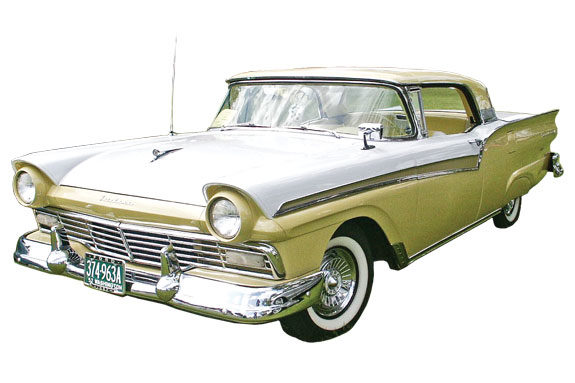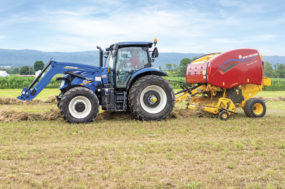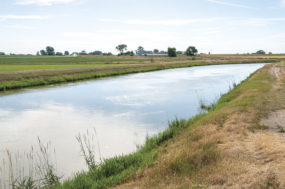Dad sold the farm when I was 10 years old and we moved to town. When I was about 15, Dad bought a 50-acre farm about seven miles out of town.
I think he bought it for my younger brothers, to have a “theater” of operations at which to teach them to work. The plan seems to have worked.
They have all been able to do all they could with the health they were blessed with to support themselves and their families. And other than Lyle and I, none of them stayed in agriculture.
By the time I was 15 years old, I had been earning my own school clothes and spending money for some time. When Dad bought “the farm,” as it was referred to, I had been on quite a few hay stacking crews. When I showed up to help Dad and the brothers stack hay, there was a problem.
Other people had taught me how to stack hay. My method was not the same as Dad’s, and we had not the communication skills between us to talk about the merits of the various ways to build a haystack. This was not good. It was almost as bad as the day that Dad offered me a pair of tennis shoes that he had purchased and just never wore.
I needed a pair for P.E. class at school. Dad was incensed that I could not use them. Mom finally played referee by pointing out that my feet were larger than Dad’s feet, and that it was nothing personal; the shoes were just too small for me.
It would have been nice if Dad and I could have gone together when I was ready for my first car. Dad would come across a car for sale in his comings and goings and send me to check it out.
I found a fatal flaw in all of these, and in retrospect, that flaw seemed to be that Dad had found the car. I ended up being the proud owner of a 1953 Mercury four-door sedan. It had the flat-head V-8 engine and a standard transmission. Had I been able to counsel together with my father, I would have run from that car.
After the new owner’s honeymoon of about two months with the car, the remainder of the time I had it I was engaged in a running battle of words with Dad as to why I needed a different, if not better, car.
It had its moments. Like the time it outran Tom Jensen’s ’56 Chevy with the 265 cubic inch V-8. And the night Scott Young and I took a shortcut home from a dance.
The rain had turned the trail we were driving on into slippery mud. I can still remember Scott screaming. I was driving and felt I was in perfect control.
To keep from bogging down in the mud I had to keep the tires spinning and that caused the car to not always be parallel with the road.
What caused Scott to scream was thinking that a large tree was about to enter his side of the car. It did not. We both survived the night without even getting the car stuck.
The radiator almost let water circulate through it, and it wanted a fresh head gasket every other month. Its crowning event was the day Dad asked me to pick him up from the tire store, where he was leaving his car.
When Dad got in it and closed his door, I tried to get the old heifer to start. It acted like the engine was flooded. I went through two or three cycles of cranking the engine, and then holding the throttle all the way down while cranking it to get more fresh air into the engine so that maybe it would blow out the too-rich gasoline and air mixture.
Then there was an explosion under the hood. The oil cap and the oil dipstick both left dents in the hood. There was the loud “BANG” and lots of smoke, but no fire. By the time I got out, Dad was across the street. The next afternoon Dad and I went car shopping and I came home the proud commandant of all 36-horsepower of a 1959 Volkswagen.
My friends had similar luck with their first set of wheels. Tom had a ’51 Chevy that used so much oil that he never changed the oil. He changed the oil filter every couple of months, and figured that the oil went through the engine so quickly that what was in it was always fresh.
When he got his second car, he listened to and then ignored the warning that the previous owner “only hit the high spots” when he drove the ’56 Chevy that replaced the ’51 oil burner.
Dean had the “Green Dragon” which was an early ’50’s Plymouth. To this day I have not seen paint that green, not even on a John Deere tractor. When a rod bearing went out, it ruined the rod journal on the crankshaft.
Dean took the offending rod and piston clear out of the engine, then put a clamp over the oil passage on the crankshaft where the bad rod had been, and drove it on five cylinders for a while.
The Green Dragon came to its end with a crankcase explosion while the car was at highway speed. Dean said it blew the oil pan clear off of the engine.
Dean’s next car was a combination of donor parts. A ’56 Chevy that his dad had injured, and then needed the six-cylinder engine for a Chevy truck before he got the car fixed.
Dean talked his dad out of the Chevy, and was given a 1953 Oldsmobile that his grandfather had rolled. One Chevy plus one Oldsmobile V-8 engine and transmission, a little burgundy paint, and Dean had his first hot-rod.
The son of one of the town’s prominent car dealers was given a choice of cars by his father. He could drive what his dad gave him to drive, or he could walk.
Jon described how the early Chrysler automatic transmission worked. It had the gear selector on the steering column just like a “normal” automatic transmission. It also had what appeared to be a clutch pedal on the floor. The car drove about the same if the driver used the “clutch pedal” thing or not.
Jon said that from a stop he could put the car in low gear, push the “clutch” pedal all the way to the floor, and race the engine until the valves “floated,” and then dump the “clutch.” The car would then gently start moving forward as the engine gradually slowed down. He was disgusted.
Even on a gravel road the car would not spin the wheels. Some years back as Jon and I sat musing about the good old times, both being in our 50s, Jon allowed that his dad’s choice of a first car for him to drive was one of “Cecil’s” best ideas. FG












